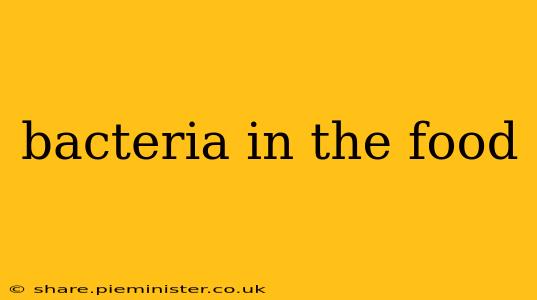Bacteria are microscopic single-celled organisms that are ubiquitous in our environment, including food. While many bacteria are harmless or even beneficial, some can cause foodborne illnesses, also known as food poisoning. Understanding how bacteria contaminate food, the risks they pose, and how to prevent contamination is crucial for maintaining food safety and public health. This comprehensive guide will explore various aspects of bacteria in food, answering common questions and providing practical advice.
What types of bacteria cause food poisoning?
Several types of bacteria can contaminate food and lead to foodborne illnesses. Some of the most common culprits include:
- Salmonella: Often found in poultry, eggs, and meat, Salmonella causes symptoms like diarrhea, fever, and abdominal cramps.
- E. coli (Escherichia coli): Certain strains of E. coli, particularly E. coli O157:H7, can cause severe diarrhea, bloody stools, and even kidney failure. It's often associated with undercooked ground beef and contaminated produce.
- Listeria monocytogenes: This bacteria can survive even in refrigerated temperatures and is particularly dangerous for pregnant women, newborns, older adults, and people with weakened immune systems. It's often found in ready-to-eat foods like deli meats and soft cheeses.
- Campylobacter: A common cause of diarrhea, often linked to undercooked poultry and contaminated water.
- Staphylococcus aureus: This bacterium produces toxins that cause nausea, vomiting, and diarrhea. It's often associated with improperly handled foods like mayonnaise-based salads and creamy desserts.
How does bacteria get into food?
Bacteria can contaminate food at various stages, from production to consumption. Key sources include:
- Animal sources: Animals can carry bacteria in their intestines, which can contaminate meat and poultry during slaughter and processing.
- Soil and water: Bacteria can be present in soil and water used to irrigate crops, leading to contamination of fruits and vegetables.
- Cross-contamination: Bacteria can spread from contaminated surfaces (e.g., cutting boards, utensils) to other foods during preparation.
- Improper handling and storage: Failure to properly refrigerate food, leaving food at room temperature for extended periods, or not cooking food to the appropriate temperature can promote bacterial growth.
- Human contamination: Food handlers who are sick or don't practice good hygiene can contaminate food through sneezing, coughing, or touching food with unclean hands.
How can I tell if food is contaminated with bacteria?
Unfortunately, there's no foolproof way to visually identify bacteria in food. Contaminated food often looks and smells normal. That's why safe food handling practices are crucial. Signs that food might be spoiled include:
- Off-odors: A sour, foul, or unusual smell.
- Changes in texture: Slimy or unusual texture.
- Changes in color: Discoloration or unusual appearance.
- Mold growth: Visible mold is a clear sign of spoilage and possible bacterial contamination.
What are the symptoms of food poisoning?
Symptoms of food poisoning vary depending on the type of bacteria and the amount ingested, but commonly include:
- Nausea and vomiting: These are often early symptoms.
- Diarrhea: Can range from mild to severe.
- Abdominal cramps: Pain in the stomach area.
- Fever: Often accompanied by chills.
- Headache: A common symptom, especially with certain types of food poisoning.
How long does it take for food poisoning symptoms to appear?
The incubation period (time between consuming contaminated food and the onset of symptoms) varies greatly depending on the type of bacteria. It can range from a few hours to several days.
How is food poisoning treated?
Treatment for food poisoning typically involves managing symptoms. This might include:
- Rest: Allowing your body to recover.
- Hydration: Drinking plenty of fluids to prevent dehydration, which can be a serious complication.
- Over-the-counter medications: For pain relief and to manage diarrhea and vomiting.
Disclaimer: This information is for educational purposes only and does not constitute medical advice. If you suspect food poisoning, seek medical attention, especially if symptoms are severe or persistent.
How can I prevent bacteria from growing in my food?
Preventing bacterial growth in food is essential for food safety. Key strategies include:
- Cleanliness: Wash hands thoroughly before and after handling food. Clean and sanitize all surfaces and utensils.
- Separation: Separate raw meat, poultry, and seafood from other foods to prevent cross-contamination.
- Cooking: Cook food to the appropriate internal temperature to kill bacteria.
- Chilling: Refrigerate perishable foods promptly.
By following these guidelines, you can significantly reduce your risk of foodborne illnesses caused by bacteria. Remember, prevention is always the best approach to food safety. Practicing safe food handling techniques ensures a healthier and more enjoyable dining experience.
